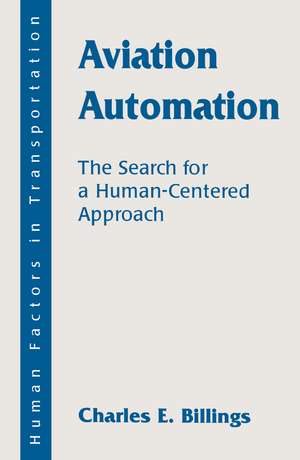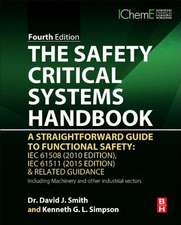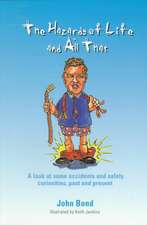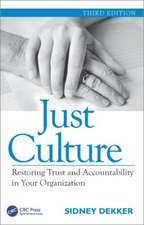Aviation Automation: The Search for A Human-centered Approach: Human Factors in Transportation
Autor Charles E. Billingsen Limba Engleză Paperback – oct 1996
Aviation automation has provided great social and technological benefits, but these benefits have not come without cost. In recent years, new problems in aircraft have emerged due to failures in the human-machine relationship. These incidents and accidents have motivated this inquiry into aviation automation. Similar problems in the air traffic management system are predicted as it becomes more fully automated. In particular, incidents and accidents have occurred which suggest that the principle problems with today's aviation automation are associated with its complexity, coupling, autonomy, and opacity. These problems are not unique to aviation; they exist in other highly dynamic domains as well. The author suggests that a different approach to automation -- called "human-centered automation" -- offers potential benefits for system performance by enabling a more cooperative human-machine relationship in the control and management of aircraft and air traffic.
| Toate formatele și edițiile | Preț | Express |
|---|---|---|
| Paperback (1) | 569.76 lei 43-57 zile | |
| CRC Press – oct 1996 | 569.76 lei 43-57 zile | |
| Hardback (1) | 1120.55 lei 43-57 zile | |
| CRC Press – noi 1996 | 1120.55 lei 43-57 zile |
Preț: 569.76 lei
Preț vechi: 670.31 lei
-15% Nou
Puncte Express: 855
Preț estimativ în valută:
109.02€ • 114.13$ • 90.21£
109.02€ • 114.13$ • 90.21£
Carte tipărită la comandă
Livrare economică 07-21 aprilie
Preluare comenzi: 021 569.72.76
Specificații
ISBN-13: 9780805821277
ISBN-10: 0805821279
Pagini: 370
Ilustrații: Illustrations
Dimensiuni: 152 x 229 x 20 mm
Greutate: 0.49 kg
Ediția:1
Editura: CRC Press
Colecția CRC Press
Seria Human Factors in Transportation
ISBN-10: 0805821279
Pagini: 370
Ilustrații: Illustrations
Dimensiuni: 152 x 229 x 20 mm
Greutate: 0.49 kg
Ediția:1
Editura: CRC Press
Colecția CRC Press
Seria Human Factors in Transportation
Public țintă
Academic, Professional, and Professional Practice & DevelopmentCuprins
Contents: Preface. Part I: Aviation Automation: Past, Present, and Future. Statement of the Problem. The Context and Environments of Aviation. A Concept of Human-Centered Automation. Part II: The Evolution and Course of Aviation Automation. Humans and the Evolution of Industrial Automation. The Evolution of Aircraft Automation. Aircraft Automation in the Future. Air Traffic Control and Management Automation. Future Air Traffic Management Automation. Part III: The Roles of Human Operators in the Aviation System. Benefits and Costs of Aviation Automation. Human and Machine Roles: Responsibility and Authority. Integration and Coupling in the Aviation System. Part IV: Issues for Future Aviation Automation. Advanced and Novel Automation Concepts for the Future System. Requirements for Aviation Automation. Requirements for Certification of Aviation Automation. Automated Systems in Other Domains. Comments and Conclusions. Appendices: Aviation Accidents and Incidents. Wiener and Curry Guidelines for Aircraft Automation (1980).
Recenzii
"This book is a comprehensive series of chapters on the numerous aspects of automation in aviation; it provides an overview of the past, present and future, the evolution of automation, the role of human operators in the aviation system and issues for the future. It is essential reading for designers of airborne and air traffic management automated systems."
—Aerospace International
"...Billings uses an historical approach that makes the book available to a wider audience than just aviation specialists. This approach is to be commended....This book is not for human factors professionals or ergonomists who specialize in aviation; it is more appropriate for specialists in related fields who need to come up to speed quickly on automation problems in air traffic control and cockpits. For such individuals this book, with its background information, is probably the best single reference available."
—Ergonomics
"Aviation Automation is an enlightened discourse written by one of the foremost authorities on this topic. It is a capable and easily accessed reference work that will likely find a favored place on the bookshelves of human factors practitioners, transportation specialists, and students, among others in the industry."
—Transportation Human Factors
"This book brings together in one carefully structured tome the impetus for automation in aviation and the strengths and pitfalls it can confer. Throughout, the book is well illustrated allowing the reader to better understand some of the uses of automation and envisage some of the issues surrounding the importance of a good interface between the human and the automated system....There is probably no other currently available book that captures the impact--both positive and negative--of automation in any one specific domain as well as this book does."
—Ergonomics Abstracts
—Aerospace International
"...Billings uses an historical approach that makes the book available to a wider audience than just aviation specialists. This approach is to be commended....This book is not for human factors professionals or ergonomists who specialize in aviation; it is more appropriate for specialists in related fields who need to come up to speed quickly on automation problems in air traffic control and cockpits. For such individuals this book, with its background information, is probably the best single reference available."
—Ergonomics
"Aviation Automation is an enlightened discourse written by one of the foremost authorities on this topic. It is a capable and easily accessed reference work that will likely find a favored place on the bookshelves of human factors practitioners, transportation specialists, and students, among others in the industry."
—Transportation Human Factors
"This book brings together in one carefully structured tome the impetus for automation in aviation and the strengths and pitfalls it can confer. Throughout, the book is well illustrated allowing the reader to better understand some of the uses of automation and envisage some of the issues surrounding the importance of a good interface between the human and the automated system....There is probably no other currently available book that captures the impact--both positive and negative--of automation in any one specific domain as well as this book does."
—Ergonomics Abstracts
Descriere
The advent of very compact, very powerful digital computers has made it possible to automate a great many processes that formerly required large, complex machinery


























